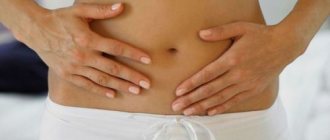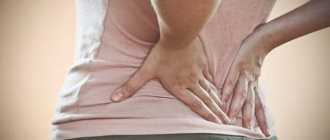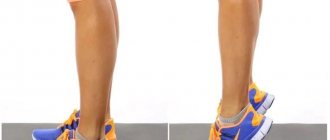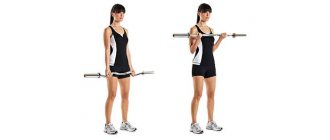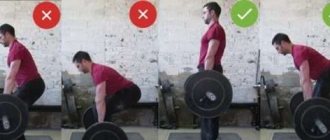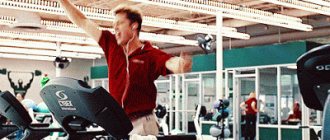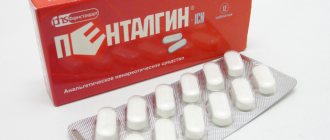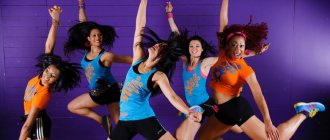muscles, soreness, pain October 29
- editor
- 1237
Krepatura (delayed onset muscle pain syndrome - DMS) is prolonged painful...
Krepatura ( with short-term muscle pain syndrome - SOMB ) an individual muscle or muscle group that occurs some time (from 12 to 72 hours) after physical activity. Krepatura is not identical to pain syndromes during or immediately after training (burning in the target muscle, feeling of fullness and stiffness), although in many ways it has a similar nature of manifestation.
To one degree or another, muscle soreness manifests itself in almost everyone involved in sports. To a greater extent - among beginners and untrained people, to a lesser extent - among experienced athletes. There is a relatively small percentage of people in whom SOMB does not manifest itself at all, regardless of the intensity of the load - this is due to the individual characteristics of the body and genetic predisposition.
Krepatura is a natural protective reaction of the human immune and nervous systems, protecting against potential injuries and helping to increase muscle strength and endurance. However, the pain can be quite strong and unpleasant, so information on how to get rid of sore throat will always be relevant.
What is muscle soreness
If the training was effective and strained the athlete’s muscles, within 24 hours they begin to noticeably ache. This is called muscle pain. You can recognize it by comparing this pain with the following sensations:
- “bloated” muscles;
- slight aches;
- difficulty performing familiar exercises;
- the pain lasts no longer than 2 days.
And here are the symptoms of the same muscle pain, but with a delay:
- painful sensations occur later - on the second day;
- pain is felt for several days to a week;
- characteristic feeling of “groaning” of the muscle.
The next morning after training, it is difficult to move and get out of bed. Even more difficult is going down the steps. If you did a leg workout the day before, the next day your legs feel stiff and your muscles act as if in slow motion.
Many people confuse muscle pain with muscle soreness. Yes, the symptoms are similar. Yet the two concepts are different.
The second, scientific name for sore throat is DOMS. Stands for delayed onset muscle pain syndrome. Every athlete is familiar with this pain. But some suffer from it once every six months, after a particularly powerful workout, while others suffer from it every month.
Krepatura has a bad effect on the athlete, his muscles and his preparation. It affects:
- training intensity;
- muscle strength;
- body composition;
- hormones;
- muscle mass.
What is DOMS
This syndrome is often compared to ordinary muscle pain. But DOMS has a stronger effect on the body, takes longer to pass and appears for other reasons. Standard pain after a good workout goes away faster than soreness.
Why does muscle soreness occur?
Previously, it was thought that the syndrome was caused by excess lactic acid lactate in the muscles. But American experts found out the truth and at the same time explained the difference between ordinary muscle pain and soreness. The first is felt when the muscles “tear” (due to the tension that arose during training, microcracks form in them). Krepatura is a completely different matter. It appears when the muscles become inflamed due to some kind of stress.
Now (thanks to the scientist guys from Louisiana) it is known that the appearance of sore throat or its absence depends on the following factors.
- Sports training of the athlete, his age, skeleton and muscles. If a person is in good physical shape, inflammation is unlikely to appear: the body is accustomed to a variety of exercises and reacts to them calmly. Krepatura occurs more often in beginners: their bodies are not accustomed to such a load. Although sometimes experienced athletes are also subjected to it. Age-related factors can affect this: weakening of the whole body, deterioration of hormones, slower regeneration.
- Damage to muscle tissue and tendons. Cracks in the muscles can become inflamed and the body will respond with pain.
- Inflammatory process. When an athlete uses new exercises with heavy weights, the body must somehow react to this. And it reacts - it covers the damaged areas with water. This causes swelling and makes exercise painful.
There is no need to worry or be afraid: everyone has gone through sore throat. This is the path to sports Olympus, or at least to a toned figure.
People who have already exercised before but took a long break (a month or more) are also susceptible to DOMS. Other reasons for the formation of sore throat include:
- changing the usual exercise equipment to new ones;
- changing the training program;
- increasing training time;
- increasing the intensity of classes;
- too much stretching.
Is it possible to exercise if your muscles are very sore after training?
Krepatura is not a case when you need to “knock out a wedge with a wedge.” During this period, it is necessary to allow the muscles to fully recover, regardless of goals and level of physical fitness. If you do physical exercises through pain, improving blood circulation and dilating blood vessels, the muscles actually stop hurting for a while. But this is not a reason to do training for already injured fibers. Exercising through pain will lead to fatigue, because pain indicates that the muscles have not yet recovered.
To get rid of soreness, you need to leave the muscles alone.
For beginners, this process is more painful until the muscles adapt. In the future, the frequency of training and the level of load can be increased. For those who are gaining weight, training with soreness is also not worth it , since muscle growth is impossible without recovery and rest.
You can work out with soreness if the program includes split training - different muscle groups are trained on separate days. While one or two groups are recovering, the next ones are training. During the period of muscle pain after strength training, you can perform cardio training if necessary and does not contradict the training goals. In any case, nothing bad will happen in a couple of days if you wait out the pain and take a break from stress.
Muscle soreness: friend or foe
There are two sides to the coin. First: soreness means that the training was intense enough, and the necessary muscles were involved. Yes, they were injured - but after this their growth will increase, they will adapt to new exercises and become stronger. Next time such a load will no longer cause pain.
But there is also a minus. Regular chronic sore throat inhibits the development of an athlete’s muscle tissue. As a result, the body runs out of resources necessary for its regeneration - pain becomes a permanent phenomenon that occurs even with light exertion.
Conclusion: sore throat is a friend, as long as you don’t stay at a party for too long.
How often to do eccentric training
If you want to get maximum results, you need to combine all training methods. This means that it is best to combine load progression with cellular fatigue and muscle damage. This also means that you need to change your training program periodically.
Therefore, it is necessary to consciously add eccentric stretches to the training session to stimulate muscle growth. There is no need to add them to each approach; 1-2 exercises per week are enough.
This will help cause noticeable progress in results. Sometimes you can spend a whole week of training focused specifically on muscle damage (soreness).
Krepatura: does muscle quality and size improve?
No, but the athlete's chances of improving quality and increasing muscle size increase.
Muscle hypertrophy can be caused by:
- mechanical tension;
- metabolic stress;
- microcracks in tissues.
The formation of microtraumas in the muscles seems to be a major factor. Yes, microtraumas contribute to the growth and enlargement of muscle tissue, but you can do without them. Muscle mass can grow well, limited by muscle tension and stress.
American doctors Schoenfeld and Contreras have long been involved in the study of muscle tissue and their internal processes. Here's what they had to say about soreness and its connection to muscle hypertrophy: “DOMS is considered a sign of only minor tissue damage. This is not the main factor and necessity. To build muscle mass, you don’t have to suffer from sore throat in the morning. It will not be a sign of successful training. Krepatura is not a guarantee of results.”
How to relieve pain
The best way to get rid of muscle soreness is to follow the preventive measures listed above.
If soreness does appear, you can use one of the traditional methods that athletes have been using since the time when delayed pain in the muscles was attributed to the action of lactic acid. Some of them activate microcirculation of blood and lymph, which helps to quickly cope with the inflammatory process in muscle fibers.
A hot bath is perhaps the most pleasant way to reduce the pain of sore throat. To enhance the effect, it is recommended to add sea salt to the bath. The hot air of a sauna and the steam room of a Russian bath have a similar effect. Some athletes prefer to take a contrast shower to reduce pain.
Methods of reducing soreness, such as massage and stretching, are best used when the peak of pain has already passed - after three days after exercise. Rough kneading and strong stretching in the midst of an inflammatory process in muscle tissue not only causes pain, but can also aggravate the problem.
Perhaps the most effective way to relieve soreness is to take NSAIDs - non-steroidal anti-inflammatory drugs (Ketorol, Diclofenac, Ibuprofen, etc.). However, due to the side effects that these drugs have, this is not recommended. NSAIDs destroy articular cartilage tissue and have a negative effect on the mucous membranes of the gastrointestinal tract. Getting rid of sore throat is not worth such risks. It is better to wait 5-7 days, and muscle soreness will disappear on its own.
Less harmful, but also less effective, are non-steroidal anti-inflammatory ointments applied externally. You can try ointments and gels based on Ibuprofen (Nurofen, Dolgit), Diclofenac (Diklak-gel, Voltaren) to relieve sore throat, but using them often is also not recommended.
Secrets of the masters: how to avoid sore throat
It’s not possible to feel nothing at all after training. But getting rid of the pain is quite possible. To do this you need to follow certain rules.
1. Take your time
It’s still not possible to build muscle in a week - it’s pointless to chase. You can’t immediately grab onto heavier weights – this won’t lead to anything good. You need to slowly increase the load, time spent on training and its intensity. As soon as the athlete gets used to his weight, he increases it - adds a couple of kilos on top. Getting used to the new load. Then it increases again. Gradual progression ensures no pain after training - and, more importantly, results.
Professional trainers advise adding 10 percent to the load and weight every week.
2. Ask for help
Gym-goers often use exercise machines incorrectly or perform exercises incorrectly. The results can vary from spasms to fractures.
A smart decision would be to seek help from the gym staff and ask questions. This will make your workouts more productive.
3. Start with light weights
Before doing a squat with a hundred, it is better to squat with an empty bar or without it at all. You need to start with light weights and low repetitions.
4. Choose the right day
Situation: Anton was going to go to the gym on Saturday morning. He packed his gym bag in advance, put the protein in a prominent place, and made an agreement with the coach. But in the evening his boss called him: Anton forgot to send an important report. He wrote it until four in the morning and fell asleep at five. At nine in the morning he called the coach and canceled the training.
Anton did the right thing. If he went to practice without getting enough sleep, he wouldn't do anyone any better. The workout would be sluggish, the body would be exhausted. It could have ended in injury.
The point is simple: if a person feels unwell, it is better to reschedule the training. And it doesn’t matter that the bag is already packed and the protein is waiting on the table.
5. Drink a lot
70 percent of muscle mass is water. If reserves are not replenished, the muscles begin to ache. A person who plays sports should drink more. It’s easy to calculate your norm: you need to divide your weight by 30. The resulting number is the number of liters that you need to drink per day.
It’s better to take a bottle of water with you to your workout and drink it gradually. Water nourishes the body, the blood does not thicken, and enough oxygen reaches the muscles.
Causes of sore throat
Muscle pain appears after every workout, no matter how long you have been doing sports (1-2 years or as long as 5 years). Even experienced athletes are not spared from sore throat. And this is good, because its appearance indicates the effectiveness of the previous load.
Typically, the peak of pain occurs in the first 3 days, but in some cases it can last up to 7-10 days. The severity of the pain depends on the novelty and intensity of the exercises performed, as well as the weight used.
There are 2 main reasons for DOMS:
- Irritation of muscle fiber receptors by accumulated lactic acid (decomposition product).
- Microscopic tears in muscle tissue.
Both phenomena occur under the influence of provoking factors :
- High intensity sports training.
- Muscle strain due to excessive activity.
- New training program.
Eccentric muscle contraction also causes soreness. It is characterized by elongation of a tense muscle under load and stretching of the muscle-tendon complex, which quickly absorbs mechanical energy.
{module Adsense block in the middle of the button}
What to do if the sore throat has already begun
Even if the pain has already appeared, it can be reduced. Below are ways to do this.
1. Acupuncture
Athletes turn to alternative medicine to tone and relieve muscle pain. During the procedure, small needles are inserted into the person. No, it doesn’t hurt – in the end it’s even pleasant. As a result, muscle tension is removed.
2. Massage
To relieve swelling after a hard workout and relieve pain, athletes go to a professional massage therapist. Home massage will not work: only a person with strong and experienced hands can stretch the muscles.
3. Rest
The most economical option. You don't need to do anything special. More precisely, nothing is needed at all. Giving yourself a week off from the gym is all that is required. This method is suitable for those who are accustomed to hoping that “it will go away on its own.” It really will!
4. Medicines
Every pharmacy sells anti-inflammatory and painkillers. Aspirin, ibuprofen, nurofen or naproxen sodium will do.
You cannot often resort to this method. Suitable for those who need to quickly get rid of painful sensations: tomorrow is an exam, interview, date, etc.
Do not take medications before starting training!
5. Sportspit
People who have little connection with sports mistake sports nutrition for doping. This is not true: sports nutrition is aimed exclusively at improving the health of the body. For example, branched chain amino acids (BCAAs) and glutamine can reduce pain in the human body and speed up the recovery process of muscle tissue.

